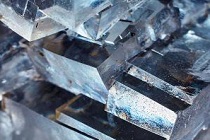 For the twenty-eighth time, the salt community met as part of the annual QUO VADIS SAL International Salt Symposium, which took place on 16-18 October 2024 in Wieliczka. PGI-NRI staff had the opportunity to present the results of their salt-related work.
For the twenty-eighth time, the salt community met as part of the annual QUO VADIS SAL International Salt Symposium, which took place on 16-18 October 2024 in Wieliczka. PGI-NRI staff had the opportunity to present the results of their salt-related work.
The XXVIII International Salt Symposium QUO VADIS SAL was organised by the Polish Salt Mining Association and hosted by the unique, historic Wieliczka Salt Mine. In the underground Drozdowice IV chamber, at a depth of 110 m, surrounded by Miocene rock salt deposits, representatives of 34 scientific and research institutions, mining and salt companies from Poland and abroad met in large numbers.
This year's session, devoted to the role of salt in Poland and Europe in times of geopolitical crisis, attracted more than 120 participants, including representatives of PGI-NRI: Patryk Bladusiak, MSc, Jacek Chełmiński, MSc, Grzegorz Czapowski, doctor habilitatus, Professor at the Institute, Marta Hodbod, PhD, Michał Michna, MSc, and Łukasz Nowacki, MSc.
The two-day programme of the symposium included six paper sessions on a variety of topics. One of the main themes was cavernous storages in salt deposits, which can play a major role in the era of the ongoing energy transition and the increasing share of renewable energy sources (RES) in the energy balance of Europe and our country.

Grzegorz Czapowski during his speech

Secondary salt mineralisation in the form of ‘cauliflowers’ and stalactites, formed at the site of water seepage
In light of being awarded this year two licences for exploration and prospecting of potash and potassium-magnesium salt deposits in the pre-Sudetic monocline, international company K2O Potash Corp. presented its investment plans along with the benefits and challenges of developing a potash salt mine.
A series of papers relating to the role of underground salt mines as historical and geotourism sites as well as being testimony to the tradition of salt mining in Poland and the world were also presented.
In the paper part of the programme, the employees of the Polish Geological Institute - National Research Institute (PGI-NRI) presented a preliminary analysis of the content of critical elements recoverable from salt formations (‘Salt formations in Poland as a potential source of selected critical elements – preliminary assessment’ – Grzegorz Czapowski, Krzysztof Bukowski), and the advantages of observations of modern evaporite sedimentation for the reconstruction and interpretation of phenomena studied in fossil material (‘Formation of salt with minerals – inspiration from the Dead Sea’ – Grzegorz Czapowski, Marta Hodbod).
In addition, they presented modern technologies of investigating salt structures using 3D modelling in the form of posters:
- ‘3D salt models from the Polish area – differences in the methodology of modelling salt structures in Zechstein formations’ – Łukasz Nowacki, Marta Hodbod, Grzegorz Czapowski, Jacek Chełmiński, Michał Michna,
- ‘3D modelling of evaporite complexes with identification of discontinuity zones and zones of thickness changes from the area of north-western Poland’ – Patryk Bladusiak.

Authors of one of the presented posters
During the conference, it was also possible to take part in a tour along the tourist route of the mine and the geological-mining route, not open to the public. The participants were acquainted with the geology of the Miocene rock salt deposit, the types of salt occurring in the mine area, the numerous and in many cases spectacular evaporite tectonic structures and the more than 700-year history of the Wieliczka Salt Mine.

Looking forward to exploring the salt pits

Salt fold structures observed during a tour of the mine

St. Kinga's Chapel – the world's biggest underground temple, located at a depth of 101 m

Miners' orchestra
The organisation of the XXVIII International Salt Symposium QUO VADIS SAL was also an opportunity for the members of the Polish Salt Mining Association to hold a general meeting. As the 3-year term of office of the Association's authorities was ending, elections to the new Executive Board were held. As a result of the vote, Marta Hodbod, PhD, from the Department of Regional and Bedrock Geology of PGI-NRI, became one of the Board members.
Text: Marta Hodbod
Photos: Patryk Bladusiak, Marta Hodbod, Michał Michna














 PGI-NRI offer
PGI-NRI offer Mineral resources of Poland
Mineral resources of Poland  Oil and Gas in Poland
Oil and Gas in Poland 




 Subscribe to RSS Feed
Subscribe to RSS Feed